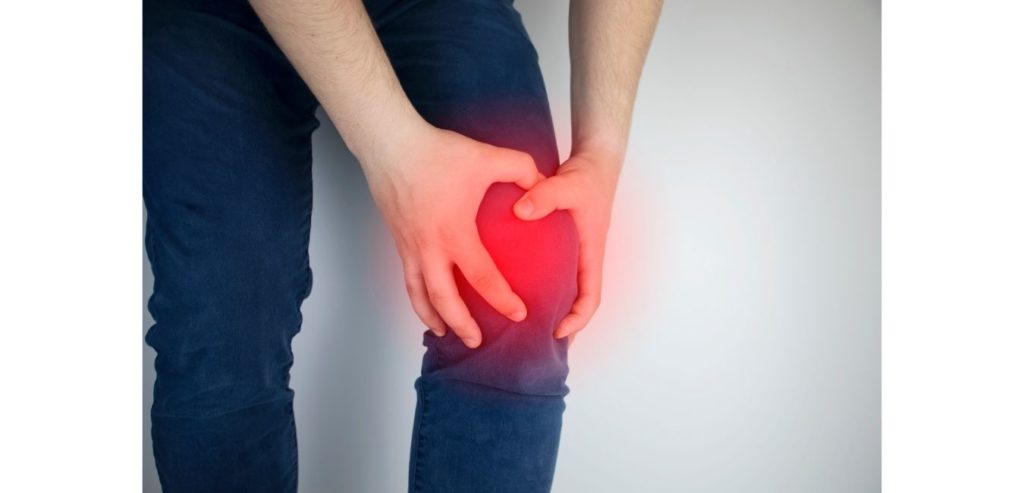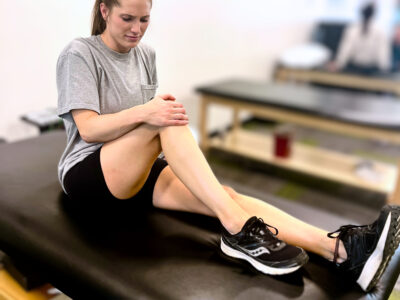Knee pain affects all age groups and all activity levels. It could be present during adolescent years going through a growth spurt to the elderly from wear and tear over the years of use. No matter what the cause, knee pain can be overwhelming and debilitating. It can keep you from the activities that you love most.
One of the most effective ways to manage knee pain and knee injuries is with physical therapy. In order to understand how physical therapy can help with knee pain, let’s take a look at how the knee works and the types of injuries that it might sustain.
A knee joint itself is a fairly simple hinge joint that primarily just has two directions of movement. The knee flexes, and extends or in other words the knee bends and it straightens.
There are major muscle groups that perform these actions namely the quadriceps and the hamstrings. The quadriceps are on the front of the thigh and the hamstrings are on the back of the thigh. The quadriceps normally are a fair amount stronger than the hamstrings are. If there is an imbalance in these muscles it can create some problems such as hamstring tears. Other muscles that can affect the knee joint are the muscles in the back, hip flexors, calf and Soleus muscles, IT band or tensor fascia latte, musculature of the lower leg and ankle.
Common Causes of Knee Pain
Many of the most common causes of knee pain are sports-related or are due to excessive amounts of wear and tear on the knee. Not only does the knee use muscles to move, but there are other structures that contribute to the function of the knees such as tendons, ligaments, nerves, and blood vessels. If these are injured it produces different symptoms. The ligaments, for example, can’t be injured and create instability in the knee.
ACL Injury
One of the most common sporting injuries is called an ACL or anterior cruciate ligament tear. This injury is characterized by instability in the knee and the inability to pivot or cut during a sporting activity. The knee will buckle and give out on someone who has an ACL tear.
Torn Meniscus
The meniscus is another structure in the knee that could be damaged as well. The meniscus is a thick piece of cartilage between the tibia and the femur. This meniscus cushions the joint to help absorb impact. Wear and tear over time, through repetitive motions, or in many cases through a traumatic sudden twisting of the knee, can tear this structure and cause pain and swelling in the knee. Pain is often felt with higher-impact activities or load-bearing activities such as weightlifting through the knee.
Tendinitis
Tendinitis of the quadriceps or patellar tendon is also a common injury that occurs in people with knee pain. The tendons of the quadriceps can become inflamed and painful through repetitive motions. Analyzing squat mechanics as well as mobility issues in the hip and knee can help to solve the problem as to why a person is developing tendinitis. If you fix the problem the tendinitis will go away.
Treatment including instrument-assisted soft tissue mobilization, other soft tissue work, and dry needling is widely imperative to decrease pain. In addition, it will improve symptoms.
IT Band Syndrome
IT band syndrome is characterized by pain that happens on the side of the knee; this is very common in runners. The tightness of a muscle in your hip called the tensor fascia lotta can cause pain that starts in the hip and goes down to the side of your knee. It can cause a snapping sensation on the side of the knee that is very painful. Stretching and foam rolling of the IT band can help to decrease symptoms of this common knee pain issue.
Physical Therapy For Knee Osteoarthritis
Osteoarthritis of the knee is another common form of pain in the elderly but also arthritis that can occur in younger populations as well if there is excessive wear and tear on the knee. Having osteoarthritis can cause severe pain and even make mobility difficult.

What Is the Best Physical Therapy for Arthritic Knees?
Arthritis can be treated through anti-inflammatory modalities done in physical therapy practices such as deep tissue laser treatment, ice compression, and electrical stimulation. Strengthening exercises can help stabilize the knee and decrease impact on the joint itself and thus decrease symptoms of osteoarthritis.
Osteoarthritis can also be caused by faulty mechanics at the knee or hip when walking. This can cause excessive wear and tear on the joint. Identifying range of motion issues, impaired strength in certain muscle groups or the hip is crucial in identifying what is causing degeneration of or wear and tear on the knee.

Schedule Your Appointment with Your American Fork Physical Therapist
Finding the source of your knee pain is imperative to being able to have successful outcomes with physical therapy. A physical therapist can do a thorough examination that measures the range of motion, strength, and neurovascular structures. This will be done for the hip, knee and ankle which is vitally important to provide the right treatment and quickest return to function.

